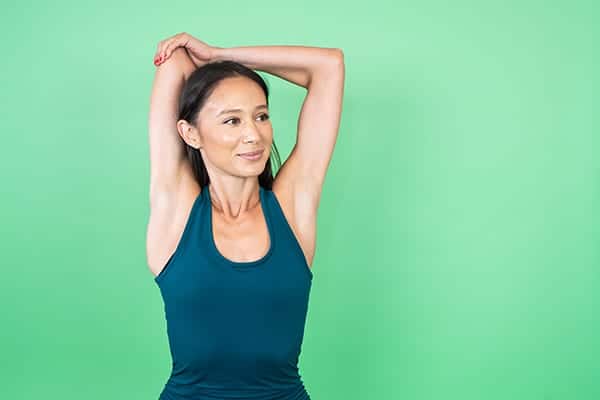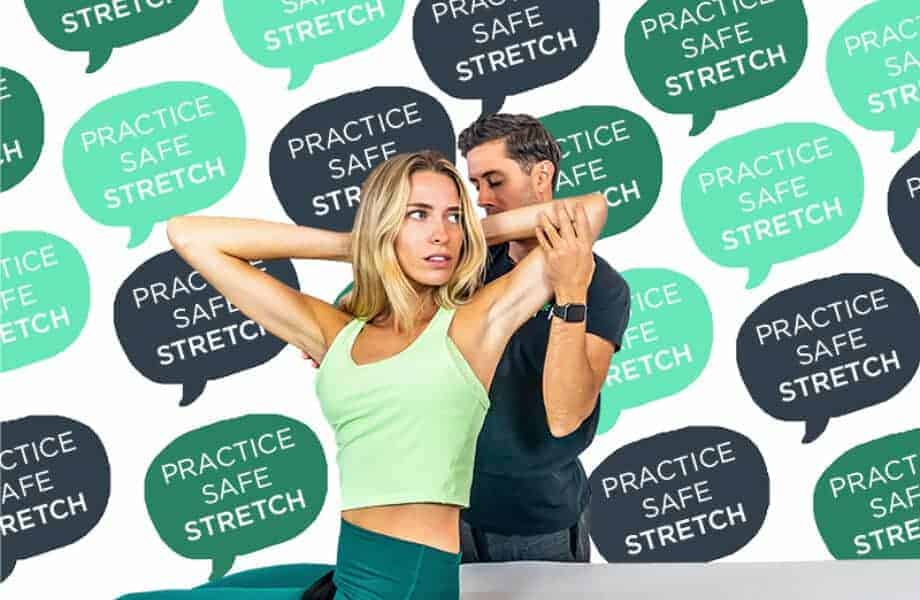The stretching you probably did in gym class
- Static stretching—you hold the same stretch (like leaning into your hamstring) for up to 30 seconds
- Ballistic stretching—as above, but add bouncing or jumping to force a ‘deeper’ stretch.
What is the ‘stretch reflex’?
Fancy name: myotactic reflex. This is when your body responds to the rapid stretching of a muscle, with a rapid contraction of the muscle (to stop it being stretched). It’s literally a knee jerk response, and you can understand why the body might do it for protection.
“The long, weight bearing holds of static stretching, and the forcefulness of ballistic stretching can initiate the stretch reflex.”
The long, weight bearing holds of static stretching, and the forcefulness of ballistic stretching can initiate the stretch reflex. Of course, this contraction is the opposite of what we’re going for when we stretch. It means the muscle cannot lengthen for an effective stretch, and also increases the risk injury whilst trying to stretch.

Active stretching avoids the stretch reflex, making it the safest and most effective way to stretch.
- In active stretching, one muscle group is engaged to work and stabilize, allowing the opposite muscle group (the one being stretched) to relax. Now your muscle is able to lengthen further with less risk of damage.
- Active stretching movements are done in 10-12 repetitions, so the stretch is progressive—your muscles won’t be pushed too hard or too fast. Would you jump out of bed and go straight into a sprint? No, because you know you need to build up to that effort gradually. The same goes for stretching.
- The repetitive movement keeps blood flowing and joints active. This increases oxygen flow to the muscles being stretched, and allows the joints to move in their full range of motion.
- All of these elements of active stretching mean that any body can be safely stretched—whether the muscles are sore and overworked or sedentary and stiff. No warm-up needed!
Our Stretch*d Method uses active stretching principles in all of our one-on-one sessions, and in the ‘Stretch*mmendations’ we provide you to do at home.
Okay, I’m learning something! What about some of the other recovery methods out there?
We love other modalities like massage, yoga, foam rolling, and percussion devices as parts of our recovery routine. Here’s a quick run-down of what makes them different (and great) in their own ways.
- Active Stretching: Lengthens the muscles for long-lasting improvements to the way your body moves and feels.
- Massage: Applies pressure to a tense muscle, causing the muscle to relax as a response. It feels great and also helps build circulation. The relief is somewhat more temporary (doesn’t necessarily address why your muscles were tight in the first place).
- Percussion devices (such as Hypervolt): Massages using very fast, small percussions to release tension in a very targeted area.
- Foam rolling: Uses pressure to release tension in the fascia (connective tissue encasing your muscles).
- Yoga: Strike a pose that combines strengthening and lengthening. Holding the static poses definitely involves muscular contraction, meaning the lengthening component is less effective than active stretching.
Do I need to have someone else stretch me? Can’t I just do it myself?
You can and should stretch yourself, but an assisted stretch has benefits you will miss by flying solo.
- With a person to move your limbs, plus custom tables and resistance straps, we can get a deeper stretch, and perform movements that you just couldn’t on your own.
- We’re stretching and movement experts—we know which stretches will be most effective for your individual body issues and needs, and we know how to perform them properly.
- We do the thinking and the hard work for you. Lay back, relax, let us get the job done.
Come in to Stretch*d for a one-one-one session of active, assisted stretching. 25-, 55-, or 70-minute sessions, completely customized to your needs.
Click here to book your next stretch

